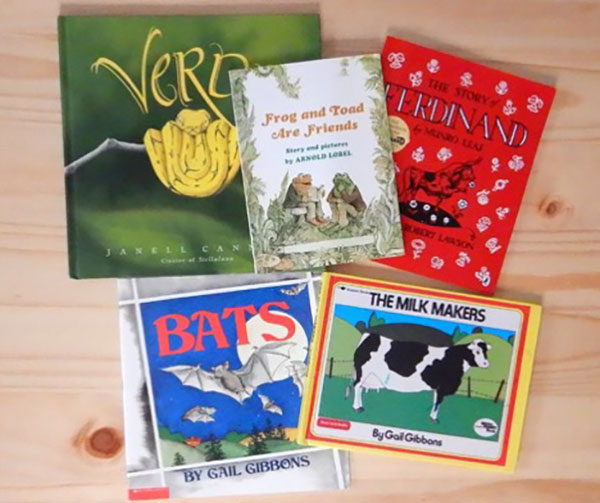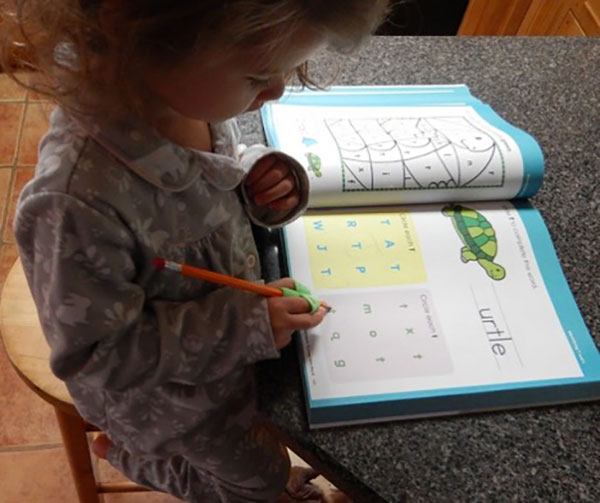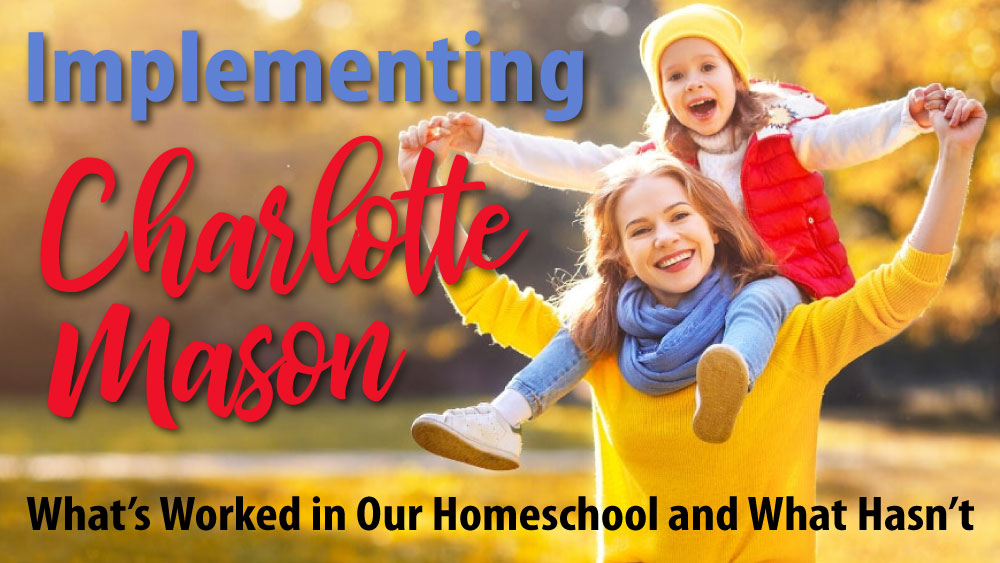When researching all of the different homeschooling methods, I was instantly drawn to the Charlotte Mason method.
Diving deeper became a little intimidating, though, as Charlotte Mason lays out such a wealth of information for parents and educators.
Nevertheless, I fell in love with Miss Mason’s philosophy of educating the whole child and with her three-pronged approach, described in her words, “Education is an Atmosphere, a Discipline, a Life.”
In this post, I’ll share about how we’ve implemented the Charlotte Mason method in our home and discuss four ways that it has worked for us and two ways it hasn’t quite fit.
What's Worked
1. Living Books Instead of “Twaddle”
Charlotte Mason believed that living books should be used for educating our children, not dry, boring textbooks that damper the imagination and love for learning.
If you’re not sure what a living book is, just think of a favorite book of yours that really brings a topic to life. A book that uses storytelling to deliver facts of information. Living books are often written by an author who has a strong passion for the subject.
These living books should also be quality books that you wouldn’t mind reading over and over again. Avoid what Charlotte Mason considered “twaddle” and steer clear of over-simplified books that have been “dumbed down.”
Since my children are young, this has been an easy concept to carry over into homeschooling. As for the “twaddle,” I went through our home library and got rid of all of the obnoxious books, minus my children’s favorites.
I now use Charlotte Mason inspired book lists and the Simply Charlotte Mason Book Finder to help find books about certain subjects and to fill our morning basket for the month.

2. Narration
Charlotte’s philosophy also suggests that no children under the age of 13 should have homework, and they shouldn’t be evaluated by written tests and quizzes.
Instead, students immediately deal with the literature at hand and narrate, orally or written, what they’ve learned from the lesson.
Not doing workbooks and tests can be a scary thing at first, but I assure you that the coupling of living books and narration can be a very powerful tool.
This has been another easy concept to apply in our homeschool. I’ve found that for preschoolers, one of the best things you can do is to just sit back and watch and listen while they play.
I’m always surprised to see the new concepts that my children have grasped coming out in their play. Young children also just love to have conversations with their parents and will casually share their observations with you.
Here are a few narration ideas for children over the age of 6:
- Tell me five things you learned about…
- Draw a picture, graph, or map of…
- Describe something new you learned from this chapter.
- Write three things you learned on our field trip to….
3. Nature Study
As a nature enthusiast, I found it quite natural to encourage outdoor exploration with my children.
My husband joins me in a passion for getting outside, exploring new places, and giving our kids plenty of time to observe and connect with God’s creation. Through hiking, kayaking, and backyard play, we discover the beauty of the natural world as a family.
My children love gathering sticks, leaves, acorns – you name it – on our walks, even if we’re just walking down the block. The joy on their faces when they see a bird at their bird feeder is priceless, and I’m sure the summer months will bring plenty of frog and toad adventures.
Nature is often your child’s first introduction to science and giving them plenty of opportunities to explore it will help form the habit of appreciating the natural world. They will also take special joy in the small things in life.
“If we give our children regular opportunities to get in touch with God’s creation, a habit is formed which will be a source of delight throughout their lives.”
- Karen Andreola, A Charlotte Mason Companion
I’m eagerly looking forward to starting nature journals and more formal nature studies with the kids once they get a little older. Nature study is definitely one of my most beloved aspects of the Charlotte Mason philosophy.

4. Creating Home Atmosphere
Charlotte Mason believed that as much as one-third of your children’s education is the atmosphere in which they are surrounded. This can be a very eye-opening concept, especially when thinking about teenagers, who are so heavily influenced by the world around them.
Charlotte stressed the importance of making the home atmosphere a priority and it has deeply influenced me to reflect upon what kind of environment we are setting for our children.
My husband and I are both now more consciously aware of the ideas that we are imparting to our children and the standards to which we are accustoming them. We are setting them up with what Charlotte Mason referred to as the “very bread of life” and exposing them not only to classic books and beautiful paintings, but also to words of kindness and respect, rich conversations, and a home that is faithful to the Word of God.
We try to have open conversations about faults and failures instead of scolding, so our children can feel comfortable coming to us with future mistakes.
In no way are we perfect, but we are doing our best to strengthen our family bond, create a love for learning, and mold little human beings into kind, passionate, hard working adults, who truly appreciate the little things in life.
What HASN'T Worked
1. Delaying Formal Lessons
The Charlotte Mason method is known for delaying formal lessons until the age of six. Rather, Charlotte thought the early years should be a “quiet growing time,” where children are surrounded with rich learning opportunities through play, observation, and first-hand experiences.
However, this philosophy is designed to protect reluctant learners, not to hold eager ones back.
“No, let us be content to be the handmaids of Nature for the first five or six years, remembering that enormous as are the tasks she sets the children, she guides them into the performance of each so that it is done with unfailing delight; for gaiety, delight, mirth, belong to her method. If a child chooses to read and write before he is six, let him, but do not make him; and when he does begin, there is no occasion to hurry; let him have a couple of years for the task.”
-The Parents Review, Volume XXIII
So, I guess, in a way, we are still technically following the method’s principles.
My preschooler mainly learns through play-based activities, field trips, and time spent out in nature, but she has been intensely eager to learn how to write and is immensely. interested in letter sounds. We have been following her lead and accommodating her thirst for knowledge.
She even has a workbook (which we purchased before finding Charlotte Mason), that she asks to do a few times a week.

2. Spending 4-6 Hours Outside
In her book, Home Education, Charlotte Mason states that young children should spend 4-6 hours outside every day, a bit less in the winter.
This goal is totally obtainable for us in the spring and fall, and we often reach it. However, the frigid winter months and hot and humid summers in Iowa can be brutal. I’m happy with getting 30-60 minutes of outdoor time in the winter. Somedays, we don’t make it outside at all, though. When wind chills are -5°? No, thank you.
The truth is, unlike Iowans, Charlotte Mason lived in a relatively mild climate in Ambleside, England. She also lived at a time when most middle and upper class families had some kind of household help, leaving parents more time to explore with their children.
The moral of the story is outdoor play should definitely be a priority in childhood, but don’t get too obsessed about the hours spent outside.
It's the Charlotte Mason Way
While a few principles of the Charlotte Mason method haven’t fit very well in our home, many of them have been a great influence in designing our own philosophy of education.
Through research and trial and error, we have found a rhythm in our home and have discovered what our family priorities are and how to accommodate the unique needs of our children.
Now this is just a snippet of how we’ve implemented the Charlotte Mason method into our homeschool. There’s really so much more to the philosophy, including habit formation, art and music appreciation, copy-work, and more.
If you want to learn more about the Charlotte Mason method, I’d recommend checking out the site, Simply Charlotte Mason or the podcast, The Mason Jar.
What About You?
Do you use the Charlotte Mason method in your home?
Which components have you found most beneficial and which ones have you struggled with?
Share your experiences in the comments below, and be sure to share this post with other homeschooling parents who are interested in the Charlotte Mason method.

Nicolle is a former zoologist turned homeschooling mom.
She and her husband homeschool their two children using the Charlotte Mason and Montessori methods.
She shares homeschooling tips, activity ideas, book lists, and more at Iowa Homeschool Mom.


2 Comments on “Implementing Charlotte Mason”
It is so interesting to see how you have molded the Charlotte Mason method to work for your family! Thanks for sharing!
Thanks Jenn! It’ll also be interesting to see how other aspects of the method play out as my children grow. We love Charlotte Mason, but it’s important to remember that you don’t have to follow a method “to the T.”